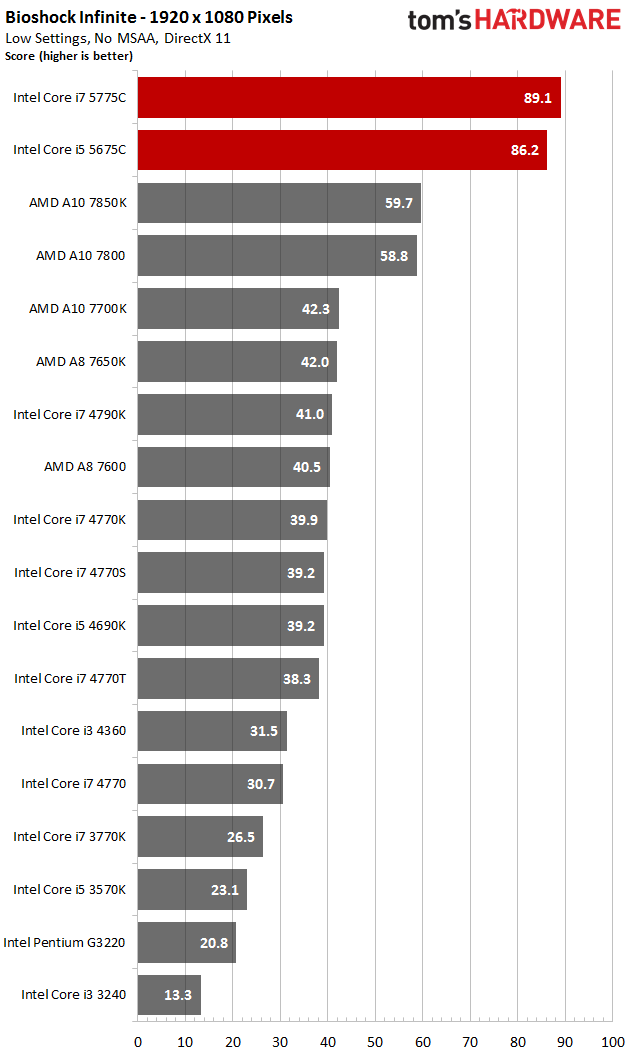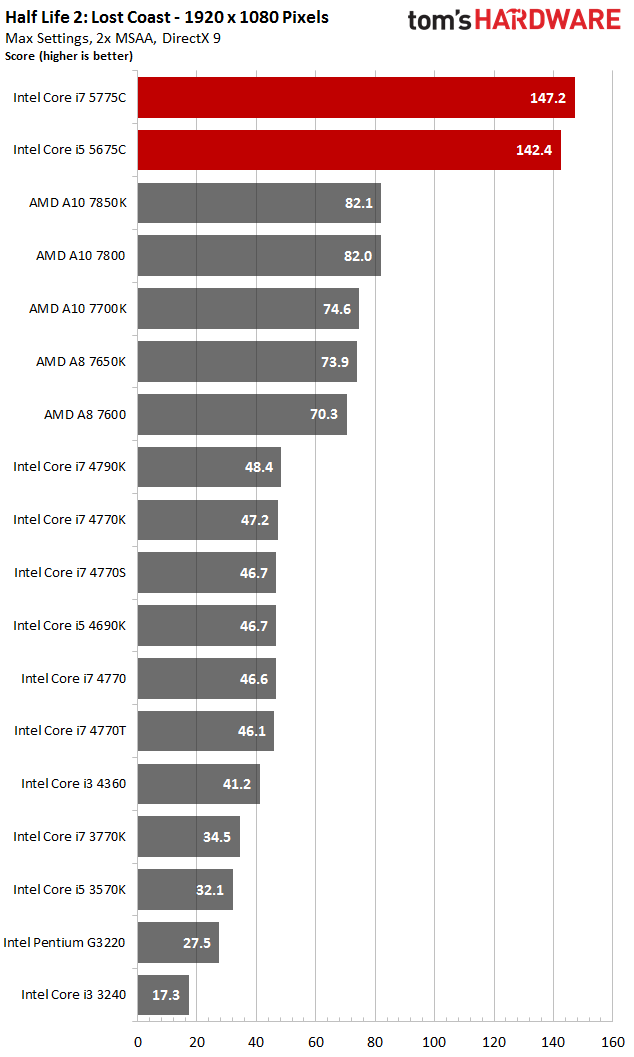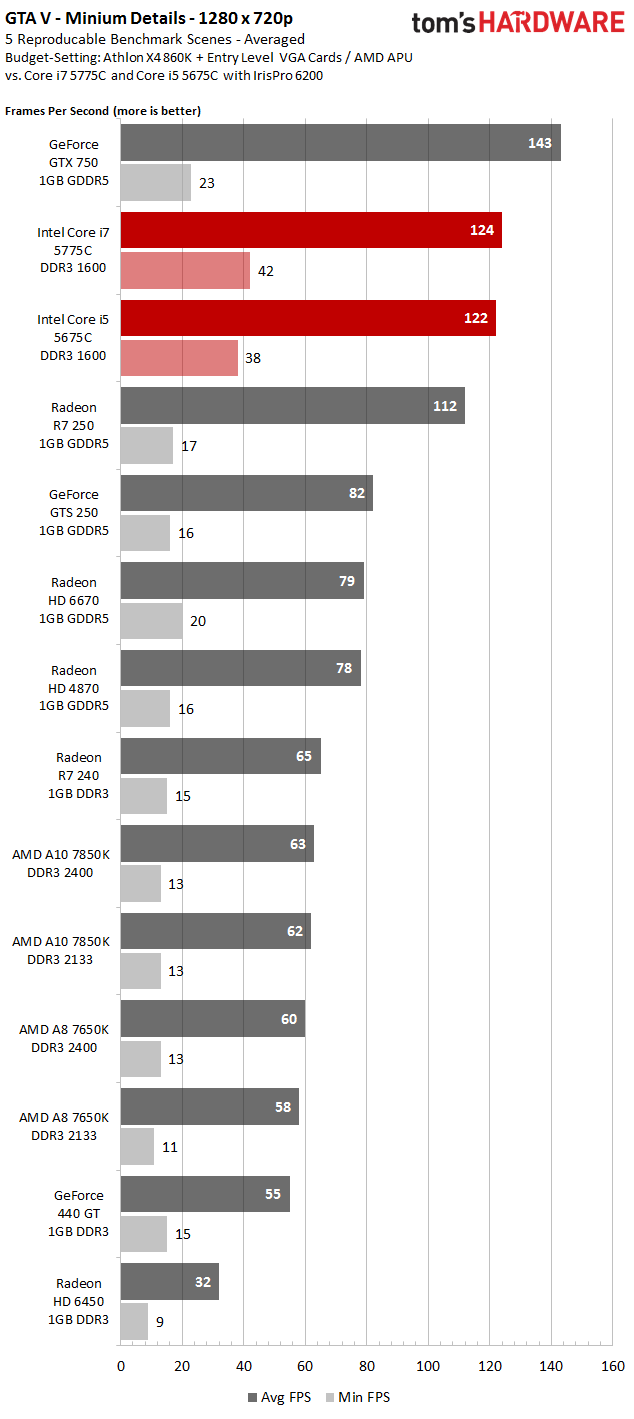Broadwell: Intel Core i7-5775C And i5-5675C Review
Iris Pro Graphics 6200: Gaming
Bioshock Infinite at 1920x1080 (DirectX 11)
Bioshock Infinite isn’t particularly demanding when it comes to graphics load (we excused it from our benchmarking suite quite a while back). However, even with our purposefully entry-level quality settings, the on-die graphics engine, not the CPU, limits performance.
Still, it's surprising that the Iris Pro 6200 with its 48 EUs offers more than twice the performance of HD Graphics 4600 found on Intel's Core i7-4790K. The company's newest design also beats AMD’s fastest APU by a massive 49 percent. The two Broadwell processors serve up 22 and 21 FPS at 1920x1080 with Ultra settings. Stepping down to the Medium preset gets you an average of 44 and 41 FPS.
These performance numbers are right around the level of an overclocked AMD Radeon R7 250X or Nvidia GeForce GTX 560 (non-Ti). That's nothing short of amazing when you consider that Iris Pro consumes somewhere between 10 and 12W.
Half-Life 2: Lost Coast at 1920x1080 (DirectX 9)
This classic has been gathering dust for a while now, but it provides a challenge that any integrated graphics engine should be able to master. Here, we have the chance to evaluate a title that's truly playable.
We’re using 2x MSAA to shift some load away from the CPU. As a result, the performance increase going from HD Graphics 4600 to Iris Pro 6200 is even more extreme. Broadwell enables frame rates three times higher. AMD's fastest APU, the A10-7800K, falls even further behind as well.
Grand Theft Auto V – Entry Level Battle
Our last benchmark is more modern, and decidedly more demanding. We’re comparing a budget-oriented system with entry-level or older graphics cards to AMD’s current APUs and Intel’s new Broadwell-based processors with Iris Pro 6200 graphics.
We also paired the fastest graphics card in this line-up with Intel’s Core i7-5775C to ensure host processing isn't limiting performance. As it turned out, the average frame rate didn't increase much compared to our machine with an AMD CPU. However, the minimum frame rate jumped quite a bit to 45 FPS.
Get Tom's Hardware's best news and in-depth reviews, straight to your inbox.
Clearly, these results look pretty good for Intel’s graphics effort. The company's new processors are definitely faster than a Radeon R7 250 with GDDR5 memory, while consuming a lot less power. AMD’s fastest APU gets destroyed; Iris Pro 6200 is twice as fast, even with its slow connection to the shared DDR3-1600.
Bottom Line
AMD’s APUs do suffer the lower IPC throughput of their host processing architectures. However, Iris Pro 6200 is still significantly faster than any integrated graphics solution that we’ve ever tested, even without help from the Broadwell architecture's efficient x86 cores. Sure, the delta would shrink if we were testing lower-clocked CPUs. But there's just no way around it: the ball is in AMD's court now.
Current page: Iris Pro Graphics 6200: Gaming
Prev Page Power Consumption Overview Next Page Iris Pro Graphics 6200: Workstation-
RNOblivion Proof read your articles. This seems to be an increasing prevalent theme of Tom's over the last couple years.Reply -
greghome are these numbers real?.............Not only does it match lower mid range cards, but it completely destorys AMD's APUs........Reply
:shock: -
Nuckles_56 With the Sandra 2015 benchmark on the first page, you are testing the i7 7557c against the i7 4790k instead of the i7 5775cReply -
babernet_1 Sad how AMD is absolutely shoved into the dust bin. I hope their upcoming Zen next year will be worthwhile with its 14nm process and more Intel-like cores.Reply
-
wtfxxxgp This is exactly what I said to a buddy of mine about a month ago. Everyone is going on about how little Intel has done with CPUs over the past few years - presumably due to no real competition from AMD. Then people starting looking to Zen as being the real competitor for Intel and saying things like "Intel are in for a shock" - I had the view that Intel weren't resting on their laurels all this time - they've just been biding their time and doing amazing things in a hush hush manner. When Zen is released it will soon be completely obliterated by some of the tech that Intel would have been working on in the meantime - AMD has lagged too far behind for too long and love them or hate them, Intel is the benchmark when it comes to CPUs - period. They own this space, and these 2 chips have just rendered AMD APUs completely useless now. I'd be interested in this for a HTPC solution with some light gaming - League of Legends etc. This is impressive, however, like the article concluded, what a poor time for them to be released.Reply -
Grognak Wow. 93% better average framerate in GTA V than a 7850K with DDR3-2400 RAM... And that's just the i5. Incredible.Reply -
shrapnel_indie Since Broadwell is unlocked, would have been interesting to see how they overclocked. Yeah Skylake is breathing down the neck of Broadwell now thanks to the delays it suffered... but still would be fun to see.Reply
You’ve waited this long—why not hang tight for a few months for Skylake and start anew with 100-series chipsets, DDR4 and the return of unlocked 95W K-series CPUs?
Last I heard Skylake was supposed to support DDR3 and DDR4. Was that just a rumor that wasn't the truth or will it actually support DDR3 as well?
-
alpha27 heh iris coming close to a 750gtx 500 cuda core NVidia better watch out heyReply
hmm if intel whacked a few iris's on a gfx chip and did there thing they could possibly beat NVidia...and make even more money lol, hmm mutli 128mb ring buses and iris core's and hbm...delicious -
de5_Roy it's a good review. two big reviews back to back, nice job. :)Reply
i missed some things:
unlocked broadwells but no o.c. not even a little look into how these overclock and behave o.c.ed.
no comparison (gaming, power use, htpc etc.) with the desktop haswell i5 and i7 -R cpus' iris pro igpus. the amd comparisons were good though. i hope you guys test these against the haswell iris pro later.
in some of the charts, the core i7 5775 was written as i7 7557.
in the test setup page, system memory section, is it "transcend" instead of "transcent"?
edit:
one last thing: do these unlocked broadwell cpus really have 16x gen 3.0 lanes off the processor? i thought these were soc dies (with southbridge disabled) with 8x gen 3.0 lanes. -
SteelCity1981 not surprising given that it has an irs pro gpu in it, that's intel top of the line gpu. now obv even with that said it's in no competition with highend gpus from NVidia or amd as any apu's gpu would get destroyed, but what's good is the fact that it's helping to push gpus on apu's to become better and better and since intel has greatly stepped up their game in the apu's gpu department i'd expect amd to step up their game even further and push back. I also see that since there is such a big gain with broadwells gpu, that skylake won't see any real jump in that department. i'd imagine that the irs 6000 series is going to carry over onto skylake with little improvement over broadwells irs 6200.Reply



